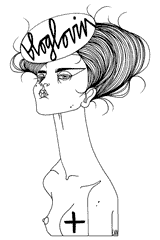The Western World, in the last 100 years or so, has been a highly charged social petri dish of incessant and rapid change in innovation, perhaps more than in any other century before it. Developments in invention, culture, science, entertainment, to name just a few of the vast number of aspects of a functioning society, has changed the manner in which humans proceed through their day-to-day existence in the most unfathomable of contexts.
The effects of war, politics, prejudice and globalisation in the 20th Century have sent slow burning oscillations through communities, sculpting everything in its path like a social tsunami, not at least, fashion.
Coming into September, with preparations for S/S 14 having their I's dotted and their T's crossed, most publications flashing the ever-so engrossing sneak peeks at what you're going to ache and yearn for in your wardrobe come March 2014 and the attempted transition between the caspm of S/S and A/W outfits are all in a revolving and bloodied tussle for attention in your head.
As imperatively marked trend prediction is, being the oxygen for designers, retailers, writers and consumers a-like, once the time for seasonal transition arrives, I enjoy taking a reflective back seat in order to see a bigger picture of magnetism. I feel some people perhaps leak the capacity to learn of the past and sacrifice such in order to perpetually follow the intoxicating hunt for the next big thing and in conjunction neglect the wider elements of what aids piece the fashion jigsaw together.
Fashion followers may possess vast knowledge of their inspirational style icons dating back 60 or 70 years in their periphery but alongside this may only possess patchy wisdom in way of the detailed dissections of the 20th Century fashion evolution.
Understanding of the effect outside factors have had upon the construction of fashion, leading into the substantial global sculpture it is in the early 21st Century, I personally see, as an exciting storyboard of avant-garde progression.
With such, this is the beginning of a sequence of blog posts examining the period of fashion progression from 1900 to the present day in an attempt to draw a timeline of instrumental changes that has come to produce the engrossing display of form we witness in the contemporary dimensions of fashion today.
Christened the haute couture era, 1900-1920 saw Paris stake it's claim as the artistic capital of the world. Silhouettes of the late 19th Century had seen narrow skirts and raised waist lines then flourish into the fashionable ideals of the early 20th century of a confident woman with a full low chest and curvy hips, making an appearance beforehand in 1830.
Parisian couturiers dipped their toes into a new century and aided in mapping the journey of women's fashion for the western world. Moreover, In 1908, a new profile presented itself from the likes of Callot Soeurs, Vionnet at the house of Doucet and most significantly Paul Poiret, a pioneer of Paris fashion, producing harem pantaloons, lampshade tunics and monumental draping
With the formerly prominent corset being described as "indispensable", pigeon breast blouses and the newly honed, popular S-Bend corset were more in demand.
The S-Bend corset aided to thrust hips backwards and forced the chest forwards to create a desired pouter-pigeon shape. Alongside this, puffed, frilly blouses aided in pronouncing this figure with embellishments of lace collars, ribbon ties and increased sleeve sizes.
As the 1900's gave way to a new decade, the hourglass silhouettes buckled to also give way to a slimmer and narrower counterpart, continuing to do so up until The Great War. Emphasis was made upon the necessity of a flatter bust and slimmer hips, in utter diverse nature to the preceding period of the century.
Upon contemplation of the 20th Century, an abundance of people would unquestionably think of only World War 2 having the most considerable impact on flowering fashion but The First World War between the years of 1914 and 1918 mutilated the line of development. Women began adopting more practical working clothes and often overalls or trousers. In the provisions of design, no significant advancement was made during this span of time and attention to detail and materials became lost in a gulf.
As previously referred to, couturier Paul Poiret danced the elegant dance of oriental opulence by introducing fluidity into his fashion house. Designs that were exotic and decadent, curating turbans, kimonos and draping. Bustles and trains were dissolved from dresses and long tunic-like tops would be worn over an ankle length a-line skirt, cinched in at the hem, creating ever-lasting appeal.
Poiret went to the places that few in fashion had the foresight, nor inclination to go, laying the foundations for subsequent generations.
Perhaps a reason as to why Poiret isn't such a powerhouse like design equivalents such as Chanel in the present day almost certainly lie at the doorstep of World War 1. Poiret served in the military until 1919 and upon return, the fashion house was flirting with bancruptcy. His designs were now viewed as "dowdy" and "ill-manufactured" in contraposition to opposing prospective fashion houses.
His considerable leverage and influence modified women's apparel forever, although often forgotten, still retains a legacy and a slice of modern women's fashion. Present day women's fashion will forever have the soft plasmas of Poiret running through its veins.






















0 comments:
Post a Comment